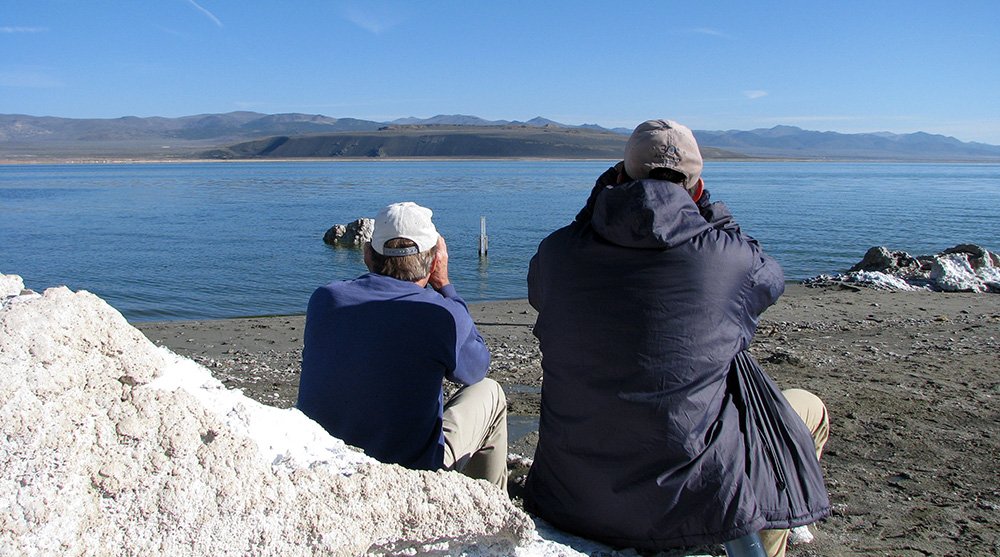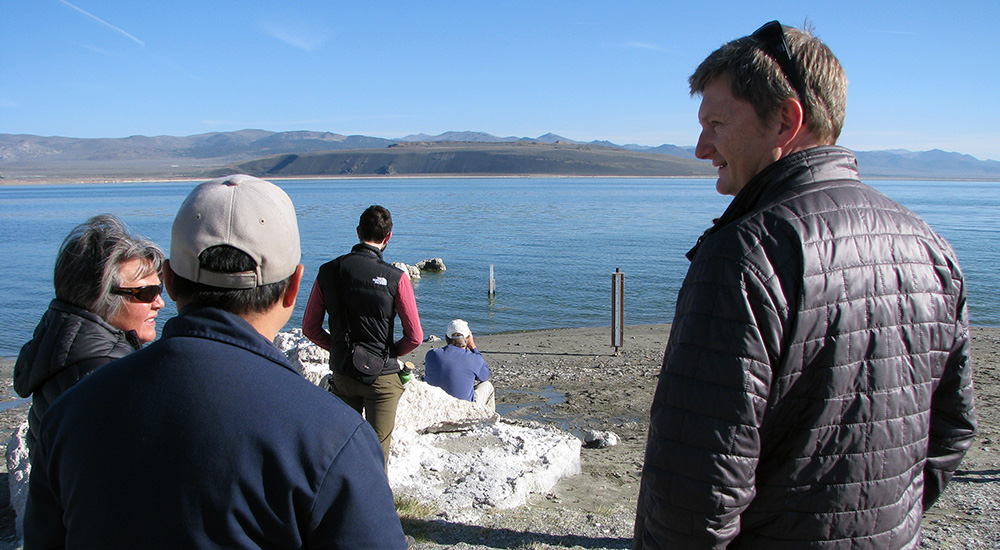
This morning Mono Lake Committee staff met with Los Angeles Department of Water & Power (DWP) personnel to conduct the official annual April 1 reading of the lake level together. The consensus: Mono Lake stands at 6379.01 feet above sea level.

The lake has declined to a level at which water exports to Los Angeles are, by the terms of the State Water Board’s rules, automatically reduced by 70%. DWP will be limited to 4,500 acre-feet of water export, a lake-protecting restriction that no one, until recently, thought would ever be activated again. It was a solemn, though not unexpected outcome, given that California’s drought is entering its fourth year and the Mono Lake watershed is officially classified as being under “exceptional” drought.
Thankfully, aggressive water conservation in Los Angeles, including Mayor Garcetti’s 20% conservation by 2017 goal, mean that even with this cutback the city’s needs and Mono Lake’s needs can both be met.
It is unavoidably disappointing to walk the shore and think of how much higher and healthier the lake was a just a few pre-drought years ago. But here’s the real shocker: how much worse it could be. If hard-won Mono Lake protection hadn’t been put into place two decades ago, the lake would be an unimaginable 29 feet lower, putting it at a salinity that would essentially end the ecosystem as we know it.
So as we start hoping for a wet 2015–16 winter, it is worth pausing to appreciate that Mono Lake stands as a shining example of how conservation and strong long-range water planning can simultaneously protect valuable natural treasures and assure that urban areas can meet their real water needs.
With that said, I now hand this update over to Greg Reis, Mono Lake Committee Information & Restoration Specialist…
Thanks Geoff!
Mono Lake has dropped 1.7 feet since we read the level a year ago. It has dropped four feet over the last three years—the driest three consecutive years on record. Just when you think it can’t get any worse, the snowpack being measured right now in the Sierra Nevada and some parts of the Mono Basin is the lowest on record, meaning this will likely be the driest year on record for snowmelt runoff in the Mono Basin. It will be a tough year for most aquatic ecosystems in California, and those in the Mono Basin are no exception.
The warm March weather already has caused the snow to start melting early, and Mono Lake to begin dropping. It dropped about a tenth of a foot in the last two weeks, and with the very low runoff expected, it may continue dropping through spring. It shouldn’t reach levels of concern for coyote predation of nesting gulls on the main nesting islets until at least next summer or fall.
Luckily a cold snowstorm is predicted for Sunday, and every little bit of precipitation will help in a year like this. Will the weather pattern change and give us an “Awesome April?” Although the April runoff forecast is quite accurate in most years, the final runoff forecast will be issued on May 1st. Over the next month and a half, both the Committee and DWP will be doing our best to predict how much the lake will drop over the next year with the latest available information. This is more challenging when it is drier than the driest year on record—with a new low data point for runoff this year, it is harder to look at the past and predict the future.
Resources:


I’m hopeful, after reading today’s updates. Calms the fears of “only one year of water left”. Don’t understand the lack of discussion/information about this most critical of issues… water!
I don’t know whether to laugh or cry about Los Angeles conserving water. How many times has a major water main of their decrepit water system burst and sent torrents of water into the sewer system? There is no end to this official huge waste of water. And, you can bank on Los Angeles going to court and obtaining an emergency “public welfare” order to rescind the Mono Lake agreement once the taps begin to run dry in Los Angeles.
And today (alas, not an April Fool’s joke), Gov. Brown ordered a mandatory statewide 25% reduction in water usage (farmers excluded). Already in place: a ban on lawns in new housing unless drip or microspray systems are in place. But has Los Angeles suspended all new housing and commercial construction? Nooooo. Now that the Great Recession is over, development has exploded in Los Angeles.
When will all the water waste of backyard pools be a topic. How about incentives for filling those pools with soils and drought resistant landscapes.
The evaporation rate of hundreds of thousands of backyard pools in California is a staggering use of water. If you think a dripping faucet is a shameful waste, just guess what the average evaporation a pool has daily during the summer? OMG… 200 to 300 gal per week on average. Average evaporation ranges from 2-3% of the pools volume. Time for sand volleyball court LA.
Her in Northrn Caifornia, everyone is doing the best to conservel. However, There appears to be no strobg leadership overlooking the entire statewide situation and setting standards for all. While we in the northern cities coonserve famously, the agriculturlal situation is seemingly disorganized and unfair. We in California cannot afford to see our agriculture decline. Ourporudcde is oen of our gfreaetest assets, asset, both domestically and internationanally. About half the country depenbds on our produce (not grains). We need to take strong neasures to provide fairness in the disbtribuition of water. Right now, whoever came first gets the most in the arid lands. And we must stop growing the dcrops which require the most wate,such as rice and nuts. It might take some kind of subsidy so that farmers with long term investment sn products such as almonds and pischtachios could change over to crdops requirign less wagter. And then, there is frackiing. Canthis be controlled to save water?
REcently I was in a southern state, and my hotel featued a beautiful, huge bathtub.But I coud not bring nmyself to fill it with water, even though we were right across from a masjor river Is it really too much to ask that swimmingpools be drained and not refilled until further notice?
Claire Isaacs Wahraftig, Berkeley
Swimming pools are not the water wasters some believe them to be. Surprisingly, the evapotranspiration rate from an open water surface is very smiilar to that of a normally watered lawn or irrigated pasture. Thus, a backyard pool may use no more water than an equal area of lawn, baring significant leaks or excessive splashing of water from the pool. Also a pool may be covered to greatly reduce evaporation. This includes solar covers used to heat the pool. There are also harmless economical chemical treatments that put a one-molecule thick film on the water surface to reduce the evaporation rate. Thus a pool and surrounding concrete decks can result in a substantial water savings compared the same area in lawn.
Draining a pool and leaving it unfilled creats a safety hazard that would be a major liability for a homeowner. It could also result in major damage to the pool as water in the pool provides lateral support for the walls. A drained pool may, therefore, be at risk of collapse, particularly if the surrounding soil is saturated. Also, saturated conditions, or even a high ground water water table could float the pool out tof the ground causing great damage. Asking people to drain their pools and fill them with dirt is asking too much for little if any benefit for water conservation.
It is unrealistic and irresponsible not to expect agriculture to cut back in their water usage. Ag has been ramping up their depletion of our states water savings account, groundwater, for years, and now it is dangerously low. Ag needs to sacrifice production for the sake of keeping their long term investments, like orchards, viable when the drought ends. The state needs to find a way to distirbute the economic losses to farmers, possibly by offering subsidies to grow less water demanding crops or even to let their fields go fallow for a season. We also need to face the not unlikely possiblity that this is not just a drought but climate change. And lets face it, we are not going to starve in America if Ag production goes down. Like the economy, land develpment, and our wonton extraction of natural resources, agricuculture cannot continue to expand indefinately. If our species wants to survive another thousand years, we will have to stop having these unrealistic expectations, accept that a declining or stagnent economy must be a reality and try to deal with it fairly. Not to mention dealing with overpopulation, and the answer is not trying to increase food production to feed everybody. Otherwise, there will be a day when our capacity to generate food will collapse. Hopefully, we are not already starting to see that in CA.
Nothing has been said about the potential fire season! Still millionions of gallions have been dumped into the delta to “save the fish” The fish will come back but we cannot replace the trees and buildings that we stand to loose in a bad fire year… and it looks bad already!…
I too am very concerned about the vast amount of waste within the DWP underground failing water system. We have experienced large losses of water in my own neighborhood due to failing infrastructure and it has even damaged properties. yet the DWP fails to take responsibility or be transparent about this. I’d like to see our government/DWP budgets be progressive and head off more problems by fixing our failing infrastructure!
Thanks everyone for the excellent comments! Although Tom, it looks like you have been misinformed. Tremendous quantities of water are diverted from the Delta, not dumped into it. 82% of the life-giving peak flow on February 9th was stored, diverted, or exported before it reached the San Francisco Estuary. Due to excessive diversions, the Bay-Delta ecosystem is in a state of permanent drought. This type of water management has been driving fish towards extinction for decades, and if the Delta smelt goes extinct this year, despite our efforts to raise it in captivity, it may not come back.
No more water should be exported from Mono Lake to LA. Just the thought seems preposterous. LA should build desalinization (sp?) plants to treat imported ocean water. That would keep the problem from recurring endlessly. LA is a rich (as well as beautiful) city and needs only a little more re-inventing. I’m hopeful – fred hayden
I am wondering when Big Ag will discover a way to industrialize “aquaponics”, a complete-cycle system of growing fish while recycling their waste to fertilize plants in a closed-circuit system that uses vastly less water than ground-based agriculture. We have laws in California that prevent the growing of tilapia for fear that they will escape and mess up wild fisheries, but there should be other fish or seafood that could substitute. Then all the lettuce, for starters, could be grown in greenhouses in poor-soil areas using much less water than current conventional methods.